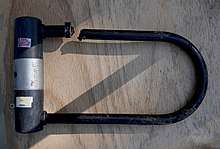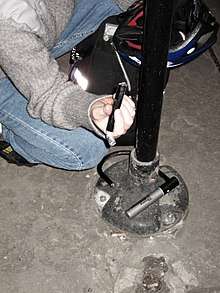Bicycle theft


Rates
According to the International Crime Victim Survey (2000), 56% of bicycle thefts across 17 countries were reported to the police.[1][2]:4 According to an estimate from the NCVS there was an estimated 1.3 million incidents of theft of or theft from bicycles.
According to the British Transport Police, theft and bicycle damage has grown 67% between 1999 and 2005.[2]:8
A 2007 report by the Birmingham Community Safety Partnership in Birmingham, England, found that the majority of bike thieves were males under the age of 20.[2]:6 According to a bicycle theft study in Ellensburg, Washington, approximately 80% of stolen bicycles are stolen for enjoyment or transportation services.[2]:6
The London Cycle Theft Survey (2016), by Stolen Ride and London Cycling Campaign, 55% reported being 'very concerned' with the security of their bikes out and about in London.[3][4]
Types of offenders
Although many bicycle thefts occur by offenders looking for financial gain, other offenders can be categorized into the following categories regarding their motivation.
- Joyriders: Joyriders steal bikes for the sole purpose of riding the stolen bike for entertainment and will generally abandon the bike after using it. Most of these offenders are male and under the age of 16.
- Acquisitive: These thieves steal bicycles for financial gain and usually trade them for cash or goods. In Portland, Oregon bike thieves are often drug addicts who provide stolen bicycles to drug dealers in exchange for drugs.[5]
Perpetrator techniques
There are a variety of methods of stealing bikes.
- Lifting
- If the bike is locked to an insecure structure such as a small sign or tree, the thief is able to lift the bike along with its lock off of the structure.
- Cutting
- A thief may use a bolt cutter, hacksaw, or angle grinder to cut through the bicycle lock.
- Picking
- A thief may pick a lock that has a keyhole.
- Sucker pole
- A sucker pole is an item of street furniture that appears to be safe to lock a bike to, but can easily be dismantled by bicycle thieves to remove the lock without opening it. A sucker pole may be a sign, fence, bike rack or other feature.[6] In Chicago, 252 bicycles were stolen in this manner in 2012.[7]
Prevention
.jpg)
Bicycle theft is a common crime committed in areas with high population as well as on college campuses. According to the Police Department at the University of Colorado, Boulder, it was found that most bicycle thefts involved bikes being unlocked, improperly locked, or locked with devices such as a lightweight cable or low-quality U-lock devices.[9]
One can prevent bicycle theft by avoiding using bicycles with quick release wheels, as these are easy for anyone to take off without the use of any tools. Furthermore, one should use a strong U-lock to secure their bike. One should only lock his or her bike to sturdy structures and should not leave the bike in one place for too long.
The way in which the bike is locked to the structure is also important. It is important that both a wheel and the frame of the bike are locked to a structure so that a thief cannot steal a wheel and leave the bike, or vice versa. A former London bike thief recommended small and stiff d-locks, as they are hardest to cut.[10]
An study published in 2012 in PLOS One examined the watching-eye effect as it applied to bicycle theft.[11] The researchers simply placed clearly visible signage saying "Cycle Thieves: We Are Watching You" (along with the words "Operation Crackdown" and the logo of local police) at locations on a university campus in England that had frequently seen bicycle theft.[11] The study found that in the year following the signage's installation, bike thefts decreased by 62% in the locations with the signs, "but increased by 65% in the control locations, suggesting that the signs were effective, but displaced offending to locations with no signs."[11]
References
- van Kesteren, J.N.; Mayhew, P.; Nieuwbeerta, P. (2000). "Criminal Victimisation in Seventeen Industrialised Countries: Key-findings from the 2000 International Crime Victims Survey". The Hague (Netherlands): Ministry of Justice, WODC.
- Thorpe, Adam; Sidebottom, Aiden; Johnson, Shane D. (June 2008). "Bicycle Theft" (PDF). Problem-Oriented Guides for Police Problem-Specific Guides Series. No. 52. U.S. Department of Justice, Office of Community Oriented Policing Services. ISBN 1-932582-87-8. Retrieved 22 February 2017. Cite journal requires
|journal=(help) - "Cycle theft survey - more bike stands and better bike locks". Stolen Ride - London. 2016-12-04. Retrieved 2017-04-14.
- "Bike stands, bike locks needed says survey". lcc.org.uk. Retrieved 2017-04-14.
- "Bike Theft Task Force | The City of Portland, Oregon". www.portlandoregon.gov. Retrieved 2020-08-09.
- Masoner, Richard (12 November 2013). "Watch for sucker poles, and a local journalist's stripped bike". cyclelicio.us. Retrieved 22 February 2017.
- Lum, Joanie (26 November 2013). "Chicago Bike Riders Watch For 'Sucker Poles'". FOX 32 News. Archived from the original on 1 February 2014. Retrieved 22 February 2017.
- "Chop Shops: Suspects stockpile bikes at homeless camps". kgw.com. Retrieved 2020-08-09.
- "Preventing Bike Theft". University of Colorado Boulder - Police Department. Retrieved 21 February 2017.
- Cantle, Richard (13 May 2016). "Bike thief reveals tricks of the trade in this shockingly candid interview". Cycling Weekly. Retrieved 21 February 2017.
- Daniel Nettle, Kenneth Nott & Melissa Bateson, 'Cycle Thieves, We Are Watching You': Impact of a Simple Signage Intervention against Bicycle Theft, PLOS One (December 12, 2012), doi:10.1371/journal.pone.0051738.
- Jaffe, Eric (16 April 2014). "These 8 Depressing Bike Theft Statistics Show Just How Bad the Problem Is". CityLab. Retrieved 22 February 2017.
- van Lierop, D.; Grimsrud, M.; El-Geneidy, A. (2015). "Breaking into bicycle theft: Insights from Montreal, Canada" (PDF). International Journal of Sustainable Transportation. 9 (7): 490-501.
External links
| Wikimedia Commons has media related to Bicycle theft. |
